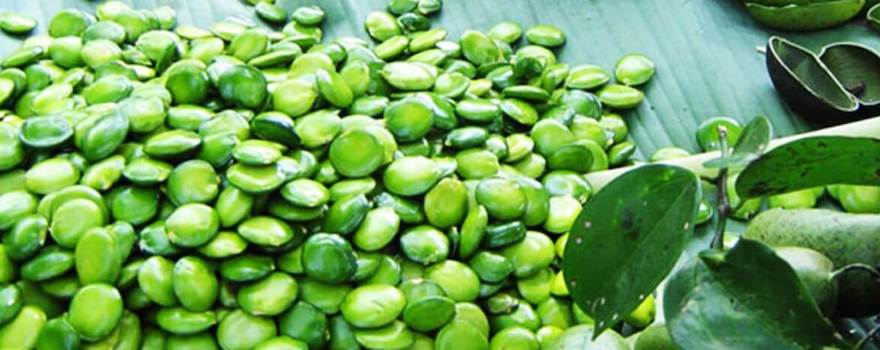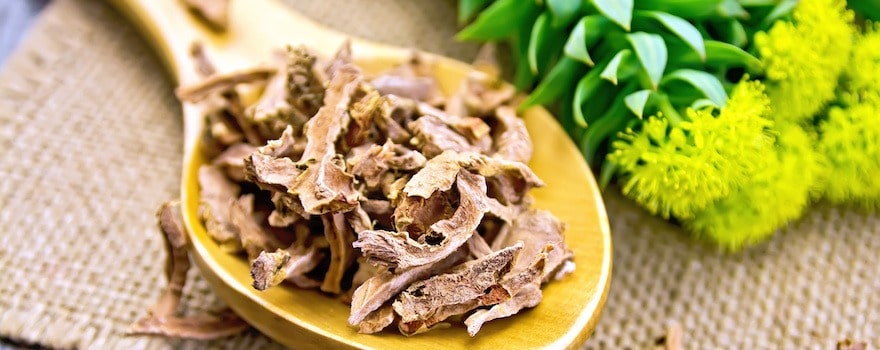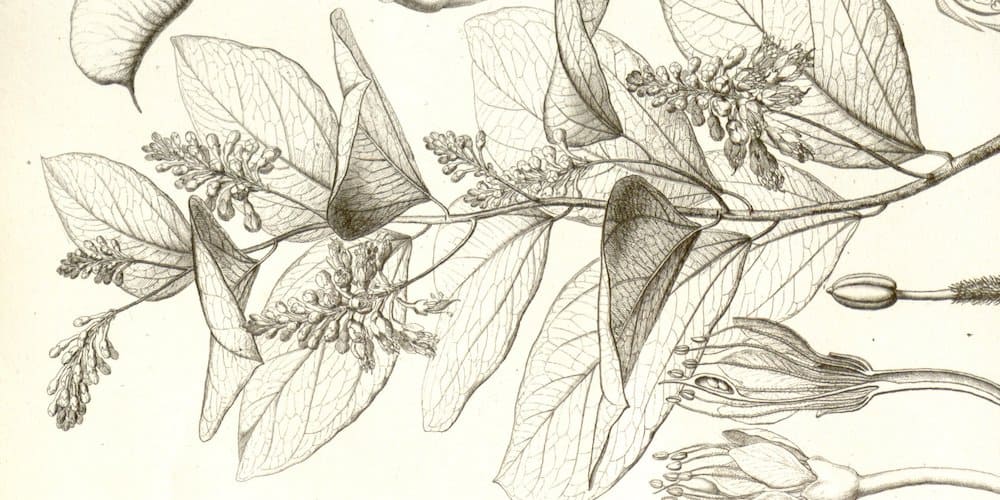BENEFITS OF GRIFFONIA
✓ Reduces stress and fights depression
✓ Restores and improves sleep
✓ Relieves migraines
✓ Eases fibromyalgia pain
✓ Regulates appetite
What is griffonia?
Native to West Africa and Central Africa, griffonia is a climbing plant belonging to the Fabaceae or legume family – like kudzu. While there are four different varieties of griffonia, it is Griffonia simplicifolia (also called Bandeiraea simplicifolia Benth) that has the most virtues and is of interest here.
Griffonia mainly grows in humid tropical forests and savannas of Ghana, Gabon, Ivory Coast, and Togo. It takes the form of a vine that, by twining around trees, can reach up to 3 meters in height. In winter, after producing green flowers, it is adorned with black pods each containing three to seven seeds.

For over 3000 years, griffonia has been an integral part of African traditional medicine. All parts of the plant are edible. People consume the stems and roots as chewing sticks to promote nervous and physical balance. It is also used in cooking for its richness in proteins.
From the 1980s, griffonia made its grand appearance in Europe. Scientists highlighted its primary active ingredient, 5-HTP (5-Hydroxytryptophan), present in large quantities in its seeds.
5-HTP is a natural precursor of serotonin, the hormone of happiness, and plays an essential role in the nervous system. It is also found that griffonia seeds are rich in minerals, vitamins, and antioxidants.
Today, griffonia is used in dietary supplements (tablets, capsules, powder, or tincture) to combat stress, depression, migraines, and sleep disorders. It also has an interest in weight loss and easing fibromyalgia pain.
Nutritional Composition
- Amino acids
- Unsaturated fatty acids: linoleic acid, oleic acid
- Saturated fatty acids: stearic acid, palmitic acid
- Active compounds: 5-HTP (5-Hydroxytryptophan), alkaloids, griffonin, rhodamine, isolectin B4
- Antioxidants
- Vitamins
- Mineral salts
- Proteins
- Carbohydrates
Benefits
🙏 Reduces stress and fights depression
Also called oxitriptan, 5-HTP contained in griffonia seeds is synthesized in the body thanks to tryptophan, an essential amino acid. First dissolved in the liver, the 5-HTP gradually moves to the brain via the bloodstream.
5-HTP is a natural precursor of serotonin, also known as the hormone of happiness. After crossing the brain’s blood-brain barrier, 5-HTP is converted into serotonin by the action of the enzyme tryptophan hydroxylase.
Serotonin contributes to nervous balance and influences cortisol levels, the stress hormone. Because it is converted into the “happiness hormone“, griffonia’s 5-HTP is therefore interesting for calming the nervous system, fighting stress and anxiety, depression, nervousness, and anguish.
In this way, it has similar properties to cacao, ashwagandha, rhodiola, or ginkgo biloba.
In this study from the Jagiellonian University Medical College, scientists listed interesting plants in the prevention and treatment of depression. Due to its 5-HTP content, griffonia naturally belongs, alongside rhodiola, St. John’s wort, or panax ginseng.
🌝 Restores and improves sleep
Griffonia’s 5-HTP is not only involved in mood regulation: it also acts on sleep by restoring the body’s biological clock.
Thus, griffonia is recommended for achieving deep and restorative sleep in the long term. It reduces the time it takes to fall asleep (i.e., the transition phase between wakefulness and sleep), improves the quality and duration of sleep, and reduces insomnia and nocturnal anxieties.
If griffonia is so effective, it’s because it acts on serotonin, involved in the regulation of sleep, as well as on another major hormone of the body: melatonin. Also called the “sleep hormone,” it is secreted by the pineal gland (located in the brain) during the evening and night.
However, 5-HTP increases the production of melatonin in the body, thus having a beneficial impact on the regulation of sleep cycles and falling asleep.
This article reveals that the administration of 5-HTP has proven effective in treating insomnia.
💆♂️ Relieves migraines
Several studies have demonstrated the anti-migraine action of griffonia. Once again, the plant owes its action to the 5-HTP it contains.
An insufficient production of serotonin by the body can lead to migraines. By regulating serotonin production, 5-HTP from griffonia reduces the intensity and duration of headaches.
In this regard, it is interesting to associate griffonia with ginkgo biloba, which, by increasing cerebral blood flow, also helps relieve migraines.
In this study conducted on 180 migraine patients, 5-HTP proved almost as effective as methysergide (a drug used in migraine management) in preventing migraines.
💆♀️ Relieves fibromyalgia pain
The action of griffonia on fibromyalgia pain (muscle and joint pain, stiffness…) is often unknown.
People suffering from fibromyalgia generally have low serotonin levels. This is why antidepressants, which act on this neurotransmitter, are commonly prescribed in such cases.
By increasing serotonin production, griffonia can help relieve symptoms of fibromyalgia, both mental and physical.
In this study from L. Sacco Hospital in Milan, conducted on 50 fibromyalgia patients, all studied symptoms were significantly improved by 5-HTP treatment.
🍽 Regulates appetite
Griffonia does not act as an appetite suppressant; it’s an appetite regulator. Thanks to its beneficial action on the nervous system, 5-HTP in griffonia relieves feelings of deprivation and psychological dependence. Symptoms that often appear in cases of obesity and eating disorders like bulimia.
Because it regulates appetite, griffonia can therefore aid in weight loss.
This study from the University of La Sapienza in Rome, conducted on patients suffering from obesity, shows that taking 5-HTP led to significant weight loss.

How to consume griffonia?
Consume the seeds
In phytotherapy, all parts of the griffonia simplicifolia are interesting. The root, leaves, bark, flowers, and even the stem are rich in active principles. But it is in the seeds of griffonia that we find the highest concentration of 5-HTP: up to 15%!
This is why it is better to favor products derived from griffonia seeds to fully benefit from the plant’s properties.
Why choose organic griffonia?
As with most plants and superfoods, it is always preferable to choose a plant sourced from organic farming.
This guarantees the absence of pesticide or chemical herbicide residues in the finished product. Organic labels also prohibit the ionization (or irradiation) of plants.
Griffonia-based supplements are easily found in pharmacies, in organic or health food stores, and online.
In tablets
Griffonia tablets or capsules contain powder obtained after the seeds are dried and ground. This is the most common and easiest form to take.
To maximize the benefits of griffonia, check the percentage of active ingredients contained in the product. Tablets or capsules should be standardized to at least 15% in 5-HTP.
In powder form
Pure griffonia powder is harder to find than tablets or capsules. It is most often mixed in a liquid: water, fruit juice, plant milk…
But griffonia powder is generally less concentrated in 5-HTP.
In mother tincture
The mother tincture of griffonia is obtained through hydro-alcoholic maceration not of the seeds but of the entire plant.
It is a form concentrated in 5-HTP and easy to administer but has the drawback of containing a lot of alcohol.
Griffonia and Rhodiola

Griffonia has an excellent synergy with rhodiola (Rhodiola rosea). Also called “golden root,” this plant is an adaptogen and is a powerful natural antidepressant.
It helps the body to overcome stress and its symptoms, reduces fatigue, and rebalances the nervous system. Like griffonia, rhodiola also plays a role in serotonin.
The griffonia/rhodiola combination is therefore ideal for enhancing the beneficial effects of griffonia and regaining mental well-being.
Additionally, taking vitamin B6 strengthens the effect of griffonia and contributes to the proper functioning of the nervous system.
Dosage
⚖️ The recommended dosage for griffonia varies between 500 and 1200 mg per day. Naturally, it should be adjusted according to your needs and the 5-HTP titer of the product.
⏳ To fully enjoy the benefits of griffonia on sleep, intake should be at the end of the day, 2 hours before bedtime. Otherwise, distribute the intake 3 times throughout the day.
⏳ Griffonia can also be consumed in the form of a course of 1 to 3 months to deeply act on depression and its symptoms. Every 2 weeks, stop taking it for a few days before resuming the course.
It is always advised to seek a doctor’s opinion before starting a griffonia course.
💊In tablets: up to 3 per day for tablets or capsules of 400 mg
🥄In powder: 1 level teaspoon per day (about 1 g)
🧪In mother tincture: 25 drops, 3 times a day
Contraindications and side effects
The consumption of griffonia presents certain contraindications. As such, it is not recommended for the following persons:
- As a precautionary measure, young children, pregnant or breastfeeding women should avoid consuming it.
- In cases of hormonal contraception, it is preferable to seek medical advice before taking griffonia.
- Griffonia consumption is contraindicated for individuals with epilepsy, those on antidepressants, or other medication for stress, anxiety, or depression.
Griffonia is a plant with rare and mild side effects that has the advantage of not causing addiction. The most commonly reported adverse effects are as follows:
- Intestinal disorders.
- Nausea.
- Drowsiness.
- Loss of appetite.
To avoid these side effects, it is important to start with small doses to allow the body time to adjust. If no symptoms occur, gradually increase the doses.
History, culture, and market
Griffonia is an African medicinal plant, consumed by both humans and livestock. All parts are used: leaves, branches, sap, seeds…
For instance, the smaller branches of griffonia are chewed to strengthen the gums. The leaves are applied to the skin to treat burns and wounds.
Griffonia leaves are also used as fodder for animals. They are given to goats and cows to strengthen their bodies and improve reproduction. In the savanna, griffonia plants are indeed a delight for grazing animals.
Compiled by Julia Perez and Charlotte Jean
Sources and scientific studies
Muszyńska B, Łojewski M, Rojowski J, Opoka W, Sułkowska-Ziaja K, 2015. Products of relevance in the prevention and supportive treatment of depression.
Birdsall TC, 1998. 5-Hydroxytryptophan: a clinically-effective serotonin precursor.
Titus F, Dávalos A, Alom J, Codina A, 1986. 5-Hydroxytryptophan versus methysergide in the prophylaxis of migraine. Randomized clinical trial.
Caruso I, Sarzi Puttini P, Cazzola M, Azzolini V, 1990. Double-blind study of 5-hydroxytryptophan versus placebo in the treatment of primary fibromyalgia syndrome.
Cangiano C, Ceci F, Cascino A, Del Ben M, Laviano A, Muscaritoli M, Antonucci F, Rossi-Fanelli F, 1992. Eating behavior and adherence to dietary prescriptions in obese adult subjects treated with 5-hydroxytryptophan.



